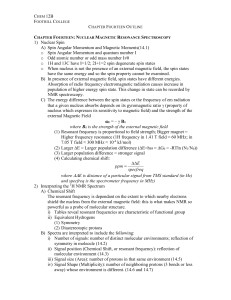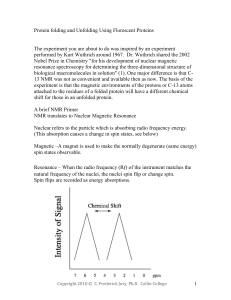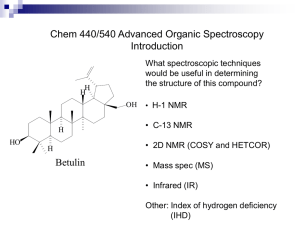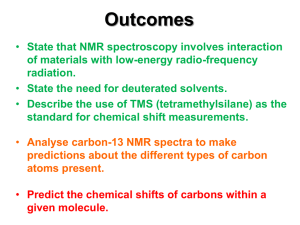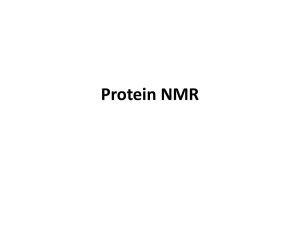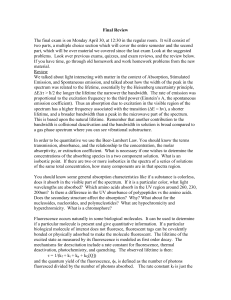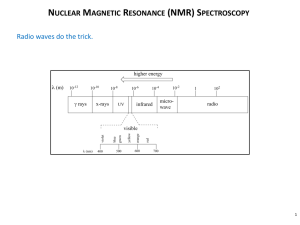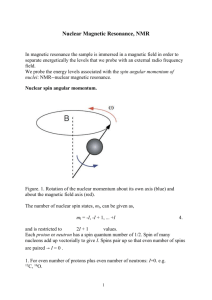Nuclear Magnetic Resonance
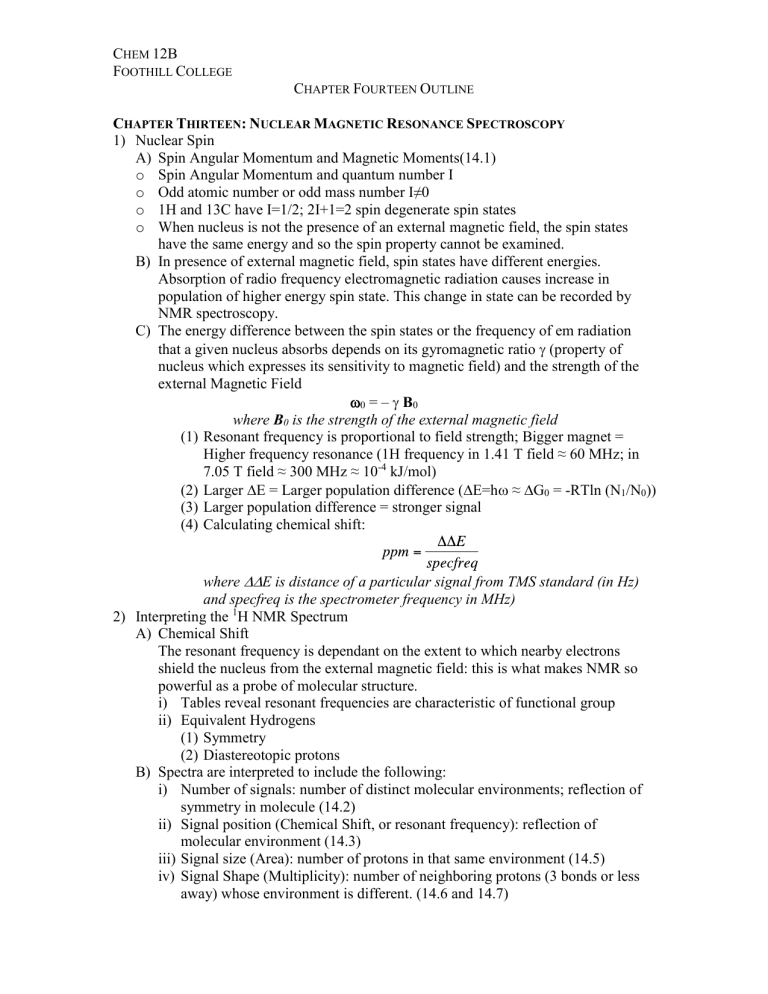
C
HEM
12B
F OOTHILL C OLLEGE
C HAPTER F OURTEEN O UTLINE
C
HAPTER
T
HIRTEEN
: N
UCLEAR
M
AGNETIC
R
ESONANCE
S
PECTROSCOPY
1) Nuclear Spin
A) Spin Angular Momentum and Magnetic Moments(14.1) o Spin Angular Momentum and quantum number I o Odd atomic number or odd mass number I≠0 o 1H and 13C have I=1/2; 2I+1=2 spin degenerate spin states o When nucleus is not the presence of an external magnetic field, the spin states have the same energy and so the spin property cannot be examined.
B) In presence of external magnetic field, spin states have different energies.
Absorption of radio frequency electromagnetic radiation causes increase in population of higher energy spin state. This change in state can be recorded by
NMR spectroscopy.
C) The energy difference between the spin states or the frequency of em radiation that a given nucleus absorbs depends on its gyromagnetic ratio
(property of nucleus which expresses its sensitivity to magnetic field) and the strength of the external Magnetic Field
0
= –
B
0 where B
0
is the strength of the external magnetic field
(1) Resonant frequency is proportional to field strength; Bigger magnet =
Higher frequency resonance (1H frequency in 1.41 T field ≈ 60 MHz; in
7.05 T field ≈ 300 MHz ≈ 10 -4 kJ/mol)
(2) Larger
E = Larger population difference (
E=h
≈
G
0
= -RTln (N
1
/N
0
))
(3) Larger population difference = stronger signal
(4) Calculating chemical shift: where
E is distance of a particular signal from TMS standard (in Hz) and specfreq is the spectrometer frequency in MHz)
2) Interpreting the
1
H NMR Spectrum
A) Chemical Shift
The resonant frequency is dependant on the extent to which nearby electrons shield the nucleus from the external magnetic field: this is what makes NMR so powerful as a probe of molecular structure. i) Tables reveal resonant frequencies are characteristic of functional group ii) Equivalent Hydrogens
(1) Symmetry
(2) Diastereotopic protons
B) Spectra are interpreted to include the following: i) Number of signals: number of distinct molecular environments; reflection of symmetry in molecule (14.2) ii) Signal position (Chemical Shift, or resonant frequency): reflection of molecular environment (14.3) iii) Signal size (Area): number of protons in that same environment (14.5) iv) Signal Shape (Multiplicity): number of neighboring protons (3 bonds or less away) whose environment is different. (14.6 and 14.7)
C
HEM
12B
F OOTHILL C OLLEGE
C HAPTER F OURTEEN O UTLINE
(a) Multiplicity = n+1 where n = number of neighbors v) Structure Elucidation from Molecular Formula: Degrees of Unsaturation or
Double Bond Equivalents
C) Combination Spectroscopy: Combining information from IR (and MS) with NMR to elucidate molecular structure
3) Interpreting the 13C NMR Spectrum: (14.11)
A) Differences between 13C and 1H
B) Resonant Frequency (75 MHz in 7.05 T Field) (14.11B)
C) Range: 200 ppm corresponds to (200 ppm x 75 Hz/ppm) = 15,000 Hz (1H range is ≈ (300 x 10)= 3000 Hz)
D) Coupling to other nuclei i) 13C-13C (rare) ii) 13C-1H (instrumentally decoupled)
E) Typical spectra are evaluated on: i) Number of signals: symmetry ii) Frequency of signals: functional group iii) Size of signal gives only limited value (small corresponds to C w/out attached protons)
4) L EARNING O UTCOMES :
A) Relate the spin quantum number I of a nucleus to the number of spin states.
B) Compare the absorption frequency of a nucleus in NMR spectroscopy to that of other forms of spectroscopy (e.g. an electron in UV-Vis spectroscopy or IR spectroscopy)
C) Compare the absorption frequency of the proton nucleus to carbon-13 and phosphorus-31.
D) Predict the change in resonant frequency in the presence of a larger magnetic field.
E) Calculate the resonant frequency in ppm given its frequency in Hz and vice-versa.
F) Determine the coupling constant J of a signal from close inspection of the NMR spectrum and understand its relationship to the structure of the molecule.
G) Understand the limitations of a low-field spectrum based on non-first-order coupling
H) Use the molecular formula of a molecule in combination with its NMR spectrum to determine the structure of the molecule.
I) Assign the signals in an NMR spectrum to specific protons in the molecule
J) Predict the first-order 1H NMR spectrum of a simple molecule
C
HEM
12B
F OOTHILL C OLLEGE
C HAPTER F OURTEEN O UTLINE
5) S
AMPLE
E
XAM
P
ROBLEMS
:
Determine the structure of an organic molecule with molecular formula C4H11N consistent with the spectra below. Show all your work and label all signals used in your analysis in order to receive full credit.
6)
7) Tell whether Ha and Ha’ are DIASTEREOTOPIC in each of the following compounds
( yes or no ) then
EXPLAIN
what that means about their NMR signals:
8) i.
_____ _____
9) The coupling constant, J, between the protons of chloroethane is 7 Hz when the spectrum is obtained at 250 MHz. What is the coupling constant between these protons when the spectrum is acquired at 500 MHz?
10) Consider the IR and 1
C
5
H
12
O.
H NMR spectra of an unknown with the molecular formula
Determine the structure of the unknown and
ASSIGN
the 1 H NMR signals along with any signals in the IR used to formulate your answer.
C
HEM
12B
F OOTHILL C OLLEGE
C HAPTER F OURTEEN O UTLINE
11)
12)
